EgyptAir
EgyptAir (Egyptian Arabic: مصر للطيران, Maṣr leṭ-Ṭayarān) is the state-owned[6] flag carrier of Egypt.[10] The airline is headquartered at Cairo International Airport, its main hub, operating scheduled passenger and freight services to more than 75 destinations in the Middle East, Europe, Africa, Asia, and the Americas. Egyptair is a member of Star Alliance and the Arab Air Carriers Organization.
| |||||||
| Founded | 7 June 1932 (as Misr Airlines) | ||||||
|---|---|---|---|---|---|---|---|
| Commenced operations | July 1933 | ||||||
| Hubs | Cairo International Airport | ||||||
| Focus cities | |||||||
| Frequent-flyer program | EgyptAir Plus[1] | ||||||
| Alliance | Star Alliance | ||||||
| Subsidiaries | [2][3][4] | ||||||
| Fleet size | 67 | ||||||
| Destinations | 73[5] | ||||||
| Parent company | EgyptAir Holding Company (Government of Egypt)[6] | ||||||
| Headquarters | EgyptAir Administrative Complex Cairo, Egypt | ||||||
| Key people | |||||||
| Employees | 9,000 (December 2014)[9] | ||||||
| Website | egyptair | ||||||
History
Early years: Misr Airwork (1932–1949)
Alan Muntz, chairman of Airwork, visited Egypt in 1931; at that time, he expressed his intention of starting up a new airline in the country. The new enterprise was named Misr Airwork, with ″Misr″ being Arabic for Egypt. On 31 December 1931, the government granted the new company the exclusivity of air transport operations.[11] A division of Misr Airwork named Misr Airlines was established on 7 June 1932,[11] ″to promote the spirit of aviation among Egyptian youth″, becoming the seventh carrier in the world.[12] The headquarters of Misr Airwork, S.A.E. was in Almaza Aerodrome, Heliopolis, Cairo.[13]
The initial investment was EG£20,000, with ownership split between the Misr Bank (85%), Airwork (10%), and Egyptian private investors (5%). Operations started in July 1933, initially linking Cairo with Alexandria and Mersa Matruh using de Havilland DH.84 Dragon equipment. By August that year, the frequency on the Cairo–Alexandria service had been boosted to twice-daily.[11] In late 1933,[14] a twice-weekly Cairo–Aswan flight that called at Asyut and Luxor was inaugurated.[11] Via Port Said, a flight from Cairo that served Lydda, Haifa and Gaza was launched in 1934. On 3 August 1935, a test service via Lydda with a final destination in Nicosia began using de Havilland D.H.86 aircraft; the service was terminated on 20 October that year.[11] The Alexandria–Port Said–Cairo–Minia–Assiut route was opened in late 1935.[15] During 1935, the airline carried 6,990 passengers and 21,830 kilograms (48,130 lb) of freight; for the year, these regular services flew 419,467 miles (675,067 km).[16]
The Alexandria–Assiut route, which called at Port Said, Cairo and Minia, and the Cairo–Cyprus–Haifa–Baghdad run were the two operative services the carrier had by 1936. Hadj flights commenced in 1937. Operations to Cyprus resumed in 1938 with a Cairo–Lydda–Haifa–Larnaka service.[11] The carrier operated all-British aircraft in the early years,[17]:588 and by April 1939 the fleet comprised one D.H. Dragon, one D.H. Dragonfly, five D.H. Rapìdes, two D.H.86s and one D.H.86B that worked on the Alexandria–Cairo, Alexandria–Port Said–Cairo–Minia–Assiut, Cairo–Assiut–Luxor–Assuan, Cairo–Lydda–Haifa–Baghdad and Cairo–Port Said–Lydda–Haifa routes.[18] The Egyptian government took over all the routes in September 1939. In 1940, a service to Beirut and Palestine was started. Three Avro 19s were incorporated into the fleet in 1944. Three accidents that took place in late 1945 prompted strikes for a fleet renewal and caused operations to come to a total halt since February 1946;[11] services resumed in May, and by late 1946 the fleet included four Avro Ansons, one Beech AT-11, five Beech C-45s, four de Havilland D.H.89 Dragon Rapides and two North American AT-6 Texan.[19] The carrier benefited from the Allies' regional aircraft disposal station that sold surplus military aircraft being located in Egypt. Two more Beech C-45s were delivered in 1947, and the Vickers Viking was incorporated in 1948. In May 1949,[20] all the capital and the aircraft park was acquired by the government.[21] After the Egyptian state became the sole shareholder, the company changed its name to Misrair SAE.[20]
Misrair (1949–1957)
Misrair continued to fly the same routes as its predecessor.[21] In 1951, three Languedocs were acquired;[22] these were intended for deployment on longer routes.[21] The Languedocs replaced the Vikings on flights to Geneva, Khartoum, and Tehran.[21]
On 1 December 1952 Misrair took over the domestic competitor Services Aériens Internationaux d'Égypte (SAIDE) and thus ended the flight operations of this airline. Only the successful route Cairo-Tunis was carried over to Misrair's own route network.[23]
Three Vickers Viscounts were ordered in early 1954.[24] During that year, the carrier transported 64,539 passengers. At March 1955, Misrair's fleet comprised one Beechcraft, three Languedocs and seven Vikings; the three Viscounts were still pending delivery.[25] Douglas DC-3s were subsequently purchased and deployed on domestic routes, as well as to neighbouring Arab countries. Delivery of the first two Viscounts occurred in December 1955; they were put into service in March 1956.[21] The number of passengers transported during 1955 had grown to 77050.[26] A number of aircraft were lost during the Suez crisis.
In February 1957, Misrair was renamed United Arab Airlines.[21] Late that year, two more Viscounts were ordered at a cost of £600,000–800,000, including spares. Prior to this, an aircraft of the type was lost while standing at Almaza Airport during an air raid.[27]
United Arab Airlines (1957–1971)
Following the formation of the United Arab Republic by Egypt and Syria on 1 February 1958, Misrair was renamed United Arab Airlines (UAA) in March that year.[23][lower-alpha 1] A Cairo–Athens–Rome–Zurich service was launched on 7 July; Syrian Airways merged into UAA on 23 December, with the latter absorbing both the routes and the equipment of the Syrian carrier.[23] By March 1960, the airline had 579 employees. At that time, the fleet comprised one Beech D18S, four DC-3s, six Vikings and six Viscounts.[29]:505 One of the Viscounts crashed into the Mediterranean on 10 April, killing 17 passengers and a crew of three.[23] With registration SU-ALC,[30] the first of three Comet 4Cs[31] was delivered on 9 June.[17]:588 Operations using two of these aircraft started on 16 July the same year.[17]:588 By October 1960, Misrair had Comets deployed on the Cairo–Belgrade–Prague, Cairo–Rome–London, Cairo–Jeddah and Cairo–Khartoum runs,[17]:588 DC-3s on the Cairo–Alexandria–Mersa Matruh, Cairo–Assiut–Luxor, Cairo–Luxor–Aswan and Cairo–Port Said–Alexandria services, and Viscounts were used for the non-stop flights that linked Cairo and Alexandria.[17]:589 An order for two more Comets was placed in November 1960.[31] Syria's association with UAA ended in October 1961, when Syrian Arab Airways was established by the Syrian government in Damascus; the route network and fleet that had been taken over by UAA were returned to the new company.[32]
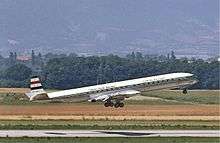
Two more Comets, the fourth and fifth ones,[23] were ordered in early 1961.[33] Three ex-SAS DC-6s were purchased in April 1961. The Cairo–Lagos run was extended to Accra on 12 June and flights to Moscow commenced on 21 June.[23] A contract with Boeing for the purchase of Boeing 707-320B with delivery dates between November 1961 and April 1964 was signed; the deal fell through when the airline could not find financing.[34] On 1 November, a new flight to Karachi and Bombay was launched, and the sixth and seventh Comets were ordered in December; these were delivered in April 1962.[35] Also in 1961, the Cairo–Nicosia run, suspended since the Suez crisis in 1956, was restored, flown with Viscount equipment.[36] Routed via Bangkok and Hong Kong, the Bombay service was extended to Tokyo in May 1962.[37] The three-strong crew of a DC-3 that crashed at Heliopolis on 16 May 1962 died, and 26 more people perished in an accident involving a Comet at Bangkok on 19 July the same year. Two more Comets were acquired in August, entering the fleet in September the same year and during 1963. On 15 February 1963, the route to Baghdad was resumed after a three-year hiatus, but the service was short-lived, as political tensions between Egypt, Iraq and Syria forced the disruption of flights to both this destination and to Damascus; on 1 April, a new service to Rhodesia was inaugurated. On 12 May 1963 a DC-3 crashed near Alexandria, killing 27 passengers and a crew of four and on 28 July 1963, a Comet crashed into the ocean near Bombay, killing 62. Short of aircraft to serve Tokyo, the route was terminated. Also, another Comet, SU-ALM, resulted damaged in Benghazi on 12 September, the ninth and final Comet was delivered in 1964. Also that year, three ex-Pan Am DC-6Bs were purchased, and another three were acquired from Northwest Orient; these aircraft were put on service on domestic routes and began replacing the Viscounts. Also aimed at operating domestic services, seven Antonov An-24s were ordered for US$2.3 million.[35]
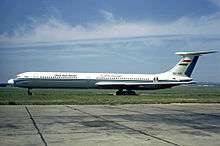
By March 1965, seven Comet 4Cs and four Viscounts flew on routes across Europe, the Middle East and North Africa, along with a service to Lagos and Accra.[20] On 1 August, a subsidiary airline named Misrair started operations.[35][lower-alpha 2] A contract worth US$30 million for three Boeing 707-320Cs was signed with Boeing on 15 June 1966 and also included four additional machines on option. On 1 November, the airline suppressed the stop at Prague on the Cairo–Prague–Moscow service, and in January 1967 UAA started the Cairo–Frankfurt–Copenhagen run. On 22 June 1967, a Comet crashed in Kuwait while landing; there were no fatalities but the aircraft was written off. In August 1968, the airline took delivery of two Ilyushin Il-18s.[35] The first Boeing 707 was handed over by the aircraft manufacturer on 21 October the same year;[39] it was later put into service on the Cairo–London corridor.[35] One of the Il-18s was involved in a deadly crash while attempting to land at Aswan Airport on 20 March 1969. That March, the carrier started services to East Berlin with Il-18 equipment and in June the route to Tokyo via Kuwait, Bombay, Bangkok and Hong Kong was resumed.[35]
On 14 January 1970, a Comet 4C (SU-ANI) crashed on landing at Addis Ababa from Cairo; no one of the 14 people on board resulted seriously injured. On 30 January 1970 the landing gear of an Antonov An-24V, SU-AOK, collapsed on touchdown at Luxor. On 19 February SU-ALE, another Comet, aborted takeoff from Munich Riem Airport at 30 feet (9.1 m), fell back to the runway, slid until the end of it and hit a fence. Another An-24V, SU-AOC, belly-landed at Cairo on 14 March.[40] At March 1970, UAA had 7,810 employees; the fleet comprised seven An-24Bs, three Boeing 707-366Cs, six Comet 4Cs and three Il-18s.[41] The fourth Boeing 707 was delivered in March 1970. An An-24V (SU-ANZ) was on a training flight and crashed near Cairo, killing the three occupants on 19 July.[40] On 2 January 1971, a Comet (SU-ALC) hit sand dunes on approach to Tripoli,[40] with the loss of lives of the eight passengers on board and the crew of eight.[12] On 23 May 1971, the acquisition of two Ilyushin Il-62s was announced, scheduled for delivery in June the same year.[40] June 1971 saw the airline using these aircraft on European routes,[40] supplementing the services operated with the Boeing 707s.[42] The Il-62s were introduced on Asian services on 9 July.[40] The name of the airline was changed to Egyptair on 10 October 1971, following the country changing its name to Arab Republic of Egypt.[43]
EgyptAir (1971–onwards)
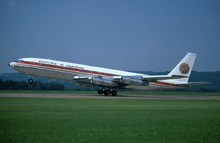
EgyptAir inherited UAA's staff, equipment, assets and liabilities. On 19 March 1972, EgyptAir Flight 763, a Douglas DC-9-32 carrying Yugoslav registration YU-AHR crashed into the Shamsan Mountains, 4 miles (6.4 km) southwest of Aden, killing all 30 occupants on board. On 16 Jun, an Ilyushin Il-62 (SU-ARN) was involved in a landing accident with no reported fatalities. In July, eight Tupolev Tu-154s were ordered for US$60 million, with three of them slated for delivery in July 1973, three in November 1973 and two in March 1974.[44] Before firming the transaction up EgyptAir had also considered the Boeing 727, but financing for these US-manufactured aircraft could not be arranged.[45] Under the terms of the contract, light maintenance was to be performed in Egypt, whereas airframe and engine overhauling was to be undertaken in the Soviet Union.[46] In July 1972, the acquisition of four Boeing 707-320Cs valued at US$40 million was announced. At this time, the airline had four Boeing 707s already in operation. The handover of the new aircraft had been arranged for March, May, June and September 1973.[44] On 5 December 1972, one of the four 707s already in the fleet (SU-AOW) crashed near Cairo while on a training flight. The crew of six perished in the accident. Reports indicating the airframe had been shot down were denied by the Egyptian government.[47] An Ilyushin Il-18, registration SU-AOY, was involved in a deadly accident near Nicosia on 29 January 1973 when it crashed into mountainous terrain, killing all 37 occupants on board.[48] Delivery of the four new Boeing 707s took place during the year, with two more 707-320Cs being ordered in September. In October the three Il-62s were returned to Aeroflot because of elevated operational costs and technical issues.[44] Also that month,[44] the first Tu-154 entered the fleet and was used for pilot training.[46] From Moscow, the handover of the Tu-154s was made through London-Heathrow, where these aircraft were fitted with British-made seats.[46]
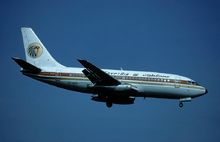
The outbreak of the Yom Kippur War in 1973 had forced the carrier to suspend the Tokyo service; it was resumed on 15 March 1974 via Bombay, Bangkok and Manila. During 1974, the flight to Khartoum was extended to Kinshasa.[44] One of the brand new Tu-154 aircraft, SU-AXB, crashed on 10 July 1974 after takeoff from Cairo International Airport during a training flight, killing a crew of six on board.[49] Following the crash EgyptAir requested the return of its Tu-154 fleet to the Soviets and a refund for the price paid for them.[50] The capacity shortage caused by the grounding of the Tu-154s was partly alleviated by the lease of aircraft.[51] The airline had already been looking for other aircraft to replace them and an order for six Douglas DC-9-50s was placed in November. On 9 December, an Il-18, registration YR-IMK, crashed into the Red Sea; there were nine fatalities. In January 1975, the government turned the order with Douglas down and moved to Boeing for the provision of new equipment. An agreement with the Soviets for the return of the Tu-154s was struck on 10 February; early in the year, the An-24s were traded back to the company that represented the Soviets as partial repayment for the loan taken to acquire the aft-engined Tu-154s. The Boeing order was finalised by March and consisted of four Boeing 727-200s and six Boeing 737-200s. There were plans to trade the first three Boeing 707-320Cs in for the new aircraft as part of the deal with Boeing.[44] Valued at US$60 million, the transaction was partly financed by the United Arab Emirates.[52] In May, the order was homogenised to eight Boeing 737-200s with deliveries slated for April and May 1976. Arrangements were made to sell the four Comets both to raise money to finance the new aircraft and to have an all-Boeing fleet.[53]
A link between Cairo and Milan began in January 1976 and a new flight to Vienna started in April. Following allegations from the Egyptian parliament that airline officials had been bribed by Boeing to favour the 1975 order, the chairman Gamal Erfan resigned in February. On 22 April, a Boeing 737 flying from Cairo to Luxor was hijacked by three Palestinians; an Egyptian commando team regained control of the aircraft with no damages to its structure. The four Comets were sold to Dan-Air on 9 October. During the year, seven Boeing 737 Advanced entered the fleet.[53] A serious accident involving a Boeing 707 took place on 25 Dec when a non-regular flight from Cairo to Tokyo crashed into a textile mill while on approach to Bangkok, killing all 43 passengers and a crew of nine; fatalities and injured people on the ground were also reported.[54] Early in 1977, the first arrests related to the bribery case involving the Boeing order took place when a former pilot admitted he had been bribed for US$150,000. In February, an agreement to lease two Airbus A300B4 aircraft from Germanair and Trans European Airlines was signed.[53][55] On 1 April, services to Abu Dhabi and Karachi were launched. The first A300 service flew the Cairo–Karachi route on 3 June.[53] The lease conditions for the aircraft owned by Bavaria Germanair changed to a lease/purchase agreement.[56] EgyptAir eventually acquired the two leased A300B4 aircraft. On 21 February 1978, a Boeing 707 made an emergency landing at Sharjah Airport after hitting a flock of birds; the incident caused substantial damage to the fuselage and the engines.[53] During 1979, three A300B4-200s were ordered for US$115 million with a delivery span between September 1980 and September 1981; the carrier took options on four more aircraft of the type.[57][58] Financing for the three firmly ordered aircraft was partly provided by the Midland Bank and the Dresdner Bank.[57]
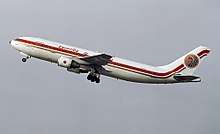
At March 1980 the number of employees was 9,610 and the fleet consisted of two Airbus A300B4s, seven Boeing 707-320Cs, seven Boeing 737-200s and two Beech Barons.[59] There was a major financial reorganisation in November 1980 when ownership of the company was shared by the National Bank of Egypt and the Misr Insurance Company.[53] In 1981, options for two Airbus A300B4-200s were converted into a firm order. This took the count of A300 aircraft pending delivery to four. At November this year the airline had five aircraft of the type in the fleet, two of them leased.[60] Another A300B4-200 was ordered in 1982.[61] Overall, eight new Airbus A300B4s were introduced during the early 1980s. Three Boeing 767-200ERs (named "Nefertiti", "Nefertari" and "Tiye") were phased in during 1984.[53] Two Boeing 767-300ERs (named "Tuthmosis III" and "Ramses II") were phased in during 1989.[53] On 31 October 1999, "Tuthmosis III" crashed into the Atlantic Ocean, killing all 217 people on board.[62]
EgyptAir is a state-owned company with special legislation permitting the management to operate as if the company were privately owned without any interference from the government. The company is self-financing without any financial backing by the Egyptian government.[63]
The airline underwent a major corporate re-engineering in 2002 when its structure was changed from a governmental organization into a holding company with subsidiaries.[64] The move coincided with the establishment of the Egyptian Minister of Civil Aviation and the government's ambitious strategy to modernize and upgrade its airports and airline. The airline was given the right to operate without any interference from the government and the duty to do so without any financial backing
EgyptAir wholly owns EgyptAir Express and Air Sinai. The airline has stakes in Air Cairo (60%) and Smart Aviation Company (20%).
In May 2006,[65] the airline launched a regional subsidiary called EgyptAir Express with a fleet of new Embraer E-170 jets with services commencing in 2007.[66] The carrier links Cairo with Sharm El Sheikh, Hurghada, Luxor, Aswan, Marsa Alam, Abu Simbel and Alexandria (Egypt) in addition to secondary destinations to complement the parent company's network. In June 2009 the subsidiary received the last of the 12 Embraer E-170 aircraft on order.
This is fortified by huge assets of more than US$3.8 billion. The airline's financial year is from July to June.[67] For the fiscal year ending 31 July 2007, EgyptAir achieved a record total revenue of US$1.143 billion. Total group revenue grew by 14%, as compared with the previous year.
In early 2007, the airline partnered with the Egyptian Ministry of Civil Aviation and Egyptian Holding Company for Airports & Air Navigation' to form a new corporate airline, Smart Aviation Company, based at Cairo Airport.
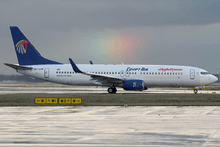
In 2009, EgyptAir's operations at its Cairo International Airport hub (where it holds 61% of the airport's departure slots) were notably overhauled due to the inauguration of the new Terminal 3 in April 2009. The airline transferred all its operations (international and domestic) to the new terminal that has more than doubled the airport's capacity. Under the Star Alliance "Move Under One Roof" concept at Cairo Airport, all Star Alliance airlines serving Cairo have moved to Terminal 3. In 2010 the airline will overhaul operations at its Alexandria base by transferring operations from the older facilities at Alexandria International Airport to the new airport in Borg El Arab Airport. The airline's CEO also stated the company was evaluating whether to set up a low-cost carrier subsidiary for its Alexandria operations to address the growth of LCCs in the city.
During the 2009–2010 Paris Airshow, the airline announced a new venture with US lessor Aviation Capital Group (ACG) and other Egyptian private and public shareholders to establish a leasing joint venture focusing on the Middle East and Northern Africa region. The new joint venture – named Civil Aviation Finance and Operating Leases (CIAF-Leasing) will initially focus on narrowbody aircraft.
Following the revolution of 2011, Egyptair is reported[68] to have suffered considerable losses. Egypt's civil aviation minister Wael El Maadawi said the airline lost an estimated 1.3 billion Egyptian pounds, or around $185 million, over the 2012/13 fiscal year, mainly due to an increase in fuel prices, the devaluation of the Egyptian currency and continuous strikes within the company. Losses for 2011/12 were apparently around double the 2012/13 figures. The carrier has reportedly suffered total losses of more than 7bn pounds, or nearly $1bn, since the 2011 uprising.
In the middle of 2012, a group of flight attendants asked for the right to wear hijabs as part of their work uniform. The company granted their request and hijab-wearing flight attendants first appeared in November 2012.[69]
In November 2015, two weeks after the crash that brought down Metrojet Flight 9268 in the Sinai peninsula, Russian authorities banned EgyptAir from flying to Russia, citing security concerns.[70]
In January 2016, EgyptAir was fined US$140,000 for leasing aircraft to Sudan Airways during 2010–11, breaking economic sanctions imposed on Sudan in 1997.[71]
In April 2018, Russian authorities lifted the ban that prevented EgyptAir from flying to Russia.[72]
EgyptAir is one of the few airlines which does not serve alcoholic beverages on its flights.[73]
As part of a restructuring of EgyptAir, Aviation Minister Air Marshall Younes Hamed announced the merger of EgyptAir Express, EgyptAir Cargo, and EgyptAir Ground Services Company with the mainline airline. As of 4 November 2019, only EgyptAir Express was officially merged with the rest of plan to be completed by the end of 2019.[3]
Corporate affairs
Ownership and structure
EgyptAir is a state-owned company, 100% owned by the Government of Egypt. The EgyptAir Holding Company[74] was created in 2002 with seven companies, with two further companies added at later dates.
There are three carriers, which operate under the same AOC but are managed separately and have their own profit and loss accounts:
- EgyptAir Airlines, the core airline company
- EgyptAir Cargo, a dedicated cargo airline (established in 2002)
- EgyptAir Express, the domestic and regional airline (launched in June 2007)
Other companies within EgyptAir Holding Company are:
- EgyptAir Maintenance & Engineering, originally an in-house operation but now also carrying out 3rd party business; EASA Part 145 and FAA Certified[74]
- EgyptAir Ground Services, providing services to over 75% of the air carriers flying to Egypt[74]
- EgyptAir In-flight Services
- EgyptAir Tourism & Duty Free Shops
- EgyptAir Medical Services
- EgyptAir Supplementary Industries Company (formed in 2006)
Subsidiaries and associates
The airline has stakes in:
Business trends
Data for the EgyptAir Holding Company and for its main subsidiary Egyptair Airlines, are shown below (for years ending 30 June):
| 2007 | 2008 | 2009 | 2010 | 2011 | 2012 | 2013 | 2014 | 2015 | 2016 | 2017 | |
|---|---|---|---|---|---|---|---|---|---|---|---|
| EgyptAir Holding Company | |||||||||||
| Turnover (E£m) | 8,959 | 12,161 | 12,998 | 13,509 | 12,890 | 14,545 | 16,593 | 16,782 | 17,734 | 17,298 | 25,084 |
| Net profit (E£m) | 579 | 695 | 573 | 533 | −2,059 | −3,106 | −1,748 | −2,817 | 37 | 13 | 72 |
| Number of passengers (m) | 7.8 | 8.2 | 7.9 | 8.7 | 8.0 | 8.2 | |||||
| Passenger load factor (%) | 72 | 68 | 66 | 69 | |||||||
| Cargo carried (tons m) | 127 | 121 | 122 | ||||||||
| Number of aircraft (at year end) | 45 | 50 | 59 | 66 | 76 | 79 | 81 | 81 | 81 | 77 | |
| EgyptAir Airlines | |||||||||||
| Turnover (E£m) | 6,947 | 9,265 | 9,917 | 10,189 | 9,678 | 10,975 | 12,877 | 13,139 | 14,140 | 13,597 | 20,010 |
| Net profits (E£m) | 161 | 232 | 208 | 130 | −2,205 | −3,069 | −1,885 | −2,923 | −0,977 | −1,279 | −5,553 |
| Number of passengers (m) | 5.7 | 6.7 | 6.8 | 7.3 | 6.8 | 7.2 | 7.8 | 7.1 | 7.4 | 7.3 | 7.0 |
| Passenger load factor (%) | 63 | 67 | 68 | 72 | 68 | 65 | 67 | 63 | 66 | 69 | |
| Number of aircraft (at year end) | 38 | 40 | 48 | 50 | 63 | 64 | 65 | 65 | 60 | 50 | |
| Notes/sources | [78][79] [80] |
[80] | [80][81] [82] |
[80][82] [83] |
[82][83] | [84][85] | [86][87] | [88] | [89] | [90] | [91] |
Trends for EgyptAir Express and EgyptAir Cargo are shown on the relevant articles. Figures for the year ending 30 June 2011, and the lack of detailed accounts since then, reflect the disruption that occurred because of the Egyptian Revolution in early 2011.
Head office
EgyptAir is headquartered in the EgyptAir Administrative Complex on the grounds of Cairo International Airport in Cairo.[92][93]
Logo
The airline's logo is Horus, the sky deity in ancient Egyptian mythology, chosen because of its ancient symbolism as a "winged god of the sun", and usually depicted as a falcon or a man with the head of a falcon.
Destinations
Alliances
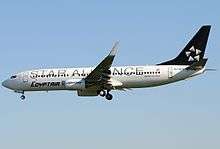
In October 2007, the Chief Executive Board of Star Alliance voted to accept EgyptAir as a future member, the first airline from an Arab country and the second African one – after South African Airways – to join the airline alliance.[94][95] In a ceremony held at Cairo International Airport on 11 July 2008, the carrier became the 21st member of this alliance, nine months after it started the joining process.[96][97]
Codeshare agreements
EgyptAir has codeshare agreements with the following airlines:[98][99]
- Aegean Airlines
- Air Canada
- Air China
- Air India
- Asiana Airlines
- Austrian Airlines
- Avianca
- Brussels Airlines
- Etihad Airways[100]
- Ethiopian Airlines
- Gulf Air
- Kenya Airways[101]
- LOT Polish Airlines[102]
- Lufthansa
- Royal Air Maroc
- Scandinavian Airlines
- Singapore Airlines
- Shenzhen Airlines
- South African Airways
- Swiss International Air Lines
- TAP Portugal
- Thai Airways
- Turkish Airlines
- Ukraine International Airlines
- United Airlines
Suspension of service to Qatar
Due to the 2017 Qatar Diplomatic crisis, Egyptair (among other carriers from Bahrain, Egypt, Saudi Arabia and the United Arab Emirates) has suspended its flights to Doha's Hamad International Airport in Qatar as per the instructions from the Egyptian Government.[104][105]
Fleet
Current fleet
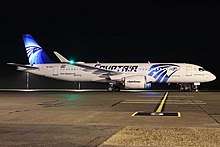
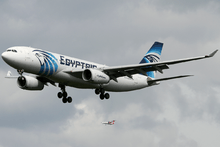
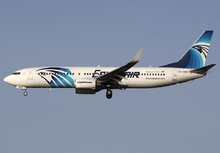
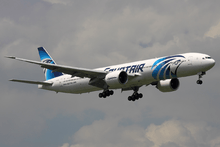
.jpg)
As of August 2020,[106] the EgyptAir mainline fleet consists of the following aircraft:[107]
| Aircraft | In service | Orders | Passengers[108] | Notes | |||
|---|---|---|---|---|---|---|---|
| C | Y | Total | |||||
| Airbus A220-300 | 10 | 2 | — | 137 | 137 | Originally ordered by merged EgyptAir Express.[4] | |
| Airbus A320neo | 8 | — | 16 | 126 | 142 | ||
| Airbus A321neo | — | 7[109] | TBA | ||||
| Airbus A330-200 | 4[110] | — | 24 | 244 | 268 | ||
| Airbus A330-300 | 4[110] | 1[110] | 36 | 265 | 301 | ||
| Boeing 737-800 | 20 | — | 24 | 120 | 144 | ||
| 9 | 16 | 138 | 154 | ||||
| Boeing 777-300ER | 6 | — | 49 | 297 | 346 | ||
| Boeing 787-9 | 6 | 2[111][109] | 30 | 279 | 309 | Deliveries from June 2019[112][113][114] | |
| Total | 67 | 12 | |||||
Fleet development
EgyptAir became Airbus A330/340's 37th customer in June 1995 when it ordered three Airbus A340s,[115] scheduled for delivery in December 1996.[116] The first, 260-seater aircraft entered the fleet in late 1996, and operated along a -300 version that was on lease from Gulf Air.[117] Also in 1995, the carrier purchased three 308-seater Boeing 777-200s for US$400 million.[118] These GE-90 powered aircraft, along with the A340-200s, were ordered for replacement of the Airbus A300B4 and Boeing 767-200 fleet.[117]
Aimed to replace the Airbus A300-600R fleet, the airline placed an order for seven Airbus A330-200 aircraft in early 2003,[119] slated for delivery in June 2004,[120] and cancelled two Airbus A340-600s it had previously ordered.[121] In June 2003, EgyptAir signed a deal worth US$150 million with Rolls-Royce for the provision of Trent 700 engines to power these seven A330s.[120][122] The first Airbus A330-300 was incorporated into the fleet in August 2010.[123]
EgyptAir's commercial relationship with Boeing started in 1968 when a Boeing 707 was delivered.[124] Six Boeing 737-800s were acquired in August 2005, with handovers starting in September the following year and a delivery span of three years.[125] On lease from GECAS, EgyptAir took delivery of its first 346-seater Boeing 777-300ER in March 2010.[126]
In June 2011, the airframer delivered the airline's 50th Boeing aircraft, a 737-800.[124] In July 2016, Egyptair was identified as the carrier that ordered nine more aircraft of the type, in a deal worth US$864 million.[127] In October 2016 the airline placed a firm order for eight Boeing 737-800s with deliveries starting in February 2017.[128]
In October and November 2017, it was announced that the airline intended to place an order for 6 Boeing 787-9s and 15 Airbus A320neos.[129][130]
During the 2019 Dubai Airshow, the initial order of 15 Airbus A320neos was changed to 7 A321neos and 8 A320neos instead. Also, at the same time, 2 additional Boeing 787-9 were ordered after the 6th and last Boeing 787-9 had been delivered in August of the same year.[131][132]
Historical fleet
.jpg)
| Aircraft | Introduced | Retired | Notes |
|---|---|---|---|
| Airbus A300B4 | 1977 | 1998 | |
| Airbus A300-600 | 1988 | 2009 | |
| Airbus A321-200[91]:31 | 1997 | 2018 | |
| Airbus A340-200[133] | 1996 | 2015 | |
| Airbus A340-300 | 1995 | 1997 | |
| ATR 42-500 | 2003 | 2003 | |
| Boeing 737-500[133] | 1997 | 2015 | |
| Boeing 747-100 | 1983 | 1984 | |
| Boeing 747-200 | 1984 | 1989 | |
| Boeing 747-300 | 1988 | 2005 | |
| Boeing 767-200ER | 1984 | 1997 | |
| Boeing 767-300ER | 1989 | 2001 | |
| Boeing 777-200ER[134] | 1997 | 2018 | |
| Douglas DC-8-20 | 1978 | 1979 | |
| Douglas DC-8-30 | 1978 | 1979 | |
| Douglas DC-8-62 | 1985 | 1989 | |
| Ilyushin Il-62 | 1971[40] | Unknown | |
| Lockheed L-1011 TriStar | 1989 | 1990 | |
| McDonnell Douglas DC-9-30 | 1971 | 1973 | |
| Tupolev Tu-154 | 1973[46] | 1974[44] |
Incidents and accidents
- On 22 December 1951, SNCASE Languedoc SU-AHH of Misrair crashed west of Tehran, Iran killing all 20 people on board. The aircraft was operating an international scheduled passenger flight from Baghdad, Iraq to Tehran.[135][136]
- On 30 July 1952, SNCASE Languedoc SU-AHX of Misrair was damaged beyond economic repair in a wheels-up landing at Almaza Air Base, Cairo. The aircraft was operating an international scheduled passenger flight from Almaza to Khartoum Airport, Sudan; it returned to Cairo following a fire in No. 1 engine.[137]
- On 27 July 1963, United Arab Airlines Flight 869, a de Havilland Comet, crashed into the sea on approach to Bombay Airport, India, all 62 passengers and crew on board were killed.
- On 18 March 1966, United Arab Airlines Flight 749, an Antonov An-24, crashed while attempting to land at Cairo International Airport. All 30 passengers and crew on board were killed.
- On 20 March 1969, a United Arab Airlines Ilyushin Il-18 crashed while attempting to land at Aswan Airport. 100 of the 105 passengers and crew on board were killed in the disaster.[138]
- On 19 March 1972, EgyptAir Flight 763 crashed into a mountain on approach to Aden International Airport in Yemen killing all 30 passengers and crew on board.[139]
- On 29 January 1973, EgyptAir Flight 741 crashed on approach to Nicosia International Airport killing all 37 people on board.[140]
- On 10 July 1974, SU-AXB a Tupolev Tu-154 on a training flight crashed near Cairo Airport, killing four Soviet instructors and two Egyptair pilots.[141][142]
- On 25 December 1976, EgyptAir Flight 864 crashed into an industrial complex in Bangkok, Thailand. All 52 persons on board plus 19 people on the ground were killed.[143]
- On 17 October 1982, EgyptAir Flight 771 operated by Boeing 707 SU-APE crashed on landing at Geneva Airport, Switzerland, no fatalities but the aircraft was damaged beyond repair.[144]
- On 23 November 1985, EgyptAir Flight 648 operated by a Boeing 737 was hijacked to Malta International Airport by three men from the Abu Nidal terrorist group. Omar Rezaq was among them. An Egyptian Sky Marshall on board shot and killed one of the hijackers before being gunned down himself. After several hours of negotiations, Egyptian troops stormed the aircraft and battled with the hijackers, who threw several hand grenades and shot and killed five passengers. The aircraft was severely damaged by the explosions and fire. Two of the six crew members and 59 of the 90 passengers were killed.
- On 21 September 1987, SU-BCA, an Airbus A300 crashed at Luxor International Airport during a training flight, killing all five crew members on board. It was the first fatal accident involving an Airbus A300.[145]
- On 31 October 1999, EgyptAir Flight 990, a Boeing 767 (SU-GAP) en route from Los Angeles to Cairo (with a stopover in New York City) crashed into the Atlantic Ocean off the coast of Nantucket; all 217 passengers were killed. The relief first officer of the flight, Gameel Al-Batouti, was suspected by U.S. authorities of making flight control inputs that lead to the crash, though it could not be determined why he did so.[146] Egyptian officials have strongly disputed that claim.[147]
- On 7 May 2002, EgyptAir Flight 843, a Boeing 737-500, crashed into terrain in heavy rain, fog, and a sandstorm on its approach to Tunis, Tunisia, killing 15 of 64 occupants.[148]
- On 29 July 2011, EgyptAir Flight 667, a Boeing 777-200, sustained substantial damage in a cockpit fire at Cairo International Airport (CAI). The probable cause for the accident was identified as an electrical fault or circuit. All passengers and crew were able to escape. The plane (SU-GBP) was damaged beyond repair.[149]
- On 29 March 2016, EgyptAir Flight 181, operated by Airbus A320-232 (SU-GCB) was hijacked whilst on a Flight from Borg El Arab Airport, Alexandria to Cairo International Airport. The aircraft, with 81 passengers on board, landed at Larnaca International Airport, Cyprus, where all hostages were released and the hijacker surrendered to authorities.[150]
- On 19 May 2016, EgyptAir Flight 804, an Airbus A320-232 (SU-GCC) en route from Paris to Cairo crashed into the Mediterranean Sea, killing all 66 on board.[151][152][153] The cause remains unknown, although there were speculations of a bomb detonated on board.[154]
See also
Notes
- Despite the UAA renaming formally taking place in the autumn of 1960 following the merger of Misrair and Syrian Airways,[20] Misrair had been using the ″United Arab Airlines″ title since 1958.[28]
- The carrier was conceived to operate domestic and regional services.[21] Four An-24s made up Misrair's fleet at the time operations started, and three more were expected by year end. One of these aircraft was lost in an accident at Aswan Airport on 2 February 1966; a second aircraft was involved in a deadly accident at Cairo on 19 March, killing 30. Alexandria–Athens, Cairo–Alexandria, Cairo–Luxor, Cairo–Nicosia and Cairo–Port Said–El Arish were among the routes operated by the carrier. Misrair ceased to exist on 1 June 1968 due to poor economic performance. Operations were absorbed by UAA.[38]
References
- "Archived copy". Archived from the original on 25 June 2014. Retrieved 5 March 2014.CS1 maint: archived copy as title (link)
- "Egypt Air". Institute of Developing Economies. Japan External Trade Organization. Retrieved 9 June 2016.
- "EgyptAir Restructuring and merger with EgyptAir Express and EgyptAir Cargo". Al Mal news. 11 November 2019.
- "Egyptair Express merged with EgyptAir Airlines".
- "EgyptAir". ch-aviation. Retrieved 2 July 2016.
- Young, Kathryn M. (20 December 2014). "EgyptAir contracts Sabre to help implement transformation plan | IT & Distribution content from ATWOnline". Archived from the original on 20 December 2014. Retrieved 29 May 2020.
- "Egyptair". Star Alliance. Retrieved 29 May 2020.
- Hofmann, Kurt (12 April 2016). "EgyptAir to boost Saudi Arabian network to 200 weekly flights". Air Transport World. Archived from the original on 15 April 2016.
EgyptAir chairman and CEO Hisham El-Nahas said the routes with added frequencies are Jeddah, Riydah, [sic] Madina and Damam.
- "EGYPTAIR – Star Alliance". staralliance.com. Archived from the original on 7 June 2015.
- Hofmann, Kurt (30 May 2017). "EgyptAir receives fourth Boeing 737-800". Air Transport World. Archived from the original on 30 May 2017.
- Guttery (1998), p. 51.
- "EgyptAir – 'pioneer of air travel'". BBC News. 7 May 2002. Archived from the original on 2 February 2014.
- Flight International. 28 April 1938. p. 416 (Archive). "MISR AIRWORK, S.A.E., Almaza Aerodrome, Heliopolis."
- "Air transport – Cairo-Assuan air service". Flight. Vol. XXV no. 1304. 21 December 1933. Archived from the original on 14 December 2013.
A bi-weekly air service connecting up Cairo, Luxor and Assuan has been started by the Misr Airwork Co., of Cairo.
- "Commercial Aviation – A Misr Airwork Extension". Flight. Vol. XXIX no. 1410. 2 January 1936. p. 23. Archived from the original on 14 December 2013.
A new service has been opened by Misr Airwork between Alexandria, Port Said, Cairo, Minia and Assuit [sic] for the benefit of the cotton fraternity and to enable passengers to redirect from Alexandria to Palestine. This is made possible by the connection at Port Said with the Cairo-Haifa service. The Upper Egypt service will not be immediately reopened since the international situation has played havoc with the tourist industry.
- "Commercial Aviation – Misr Airwork's Year". Flight. Vol. XXIX no. 1421. 19 March 1936. p. 314. Archived from the original on 29 December 2013.
-
- Stroud, John (7 October 1960). "Misrair 1960 (page 588)". Flight. Vol. 78 no. 2691. Archived from the original on 7 December 2013.
- "Misrair 1960 (page 589)". Flight. Archived from the original on 7 December 2013.
- "Airline companies of the World – Misr Airwork S.A.E." Flight. Vol. XXXV no. 1583. 27 April 1939. p. 429. Archived from the original on 8 October 2013.
- Guttery (1998), p. 51–52.
- "World airline survey—United Arab Airlines – UAA". Flight International. Vol. 87 no. 2927. 15 April 1965. p. 606. Archived from the original on 27 July 2013.
- Guttery (1998), p. 52.
- "Brevities". Flight. Vol. LX no. 2234. 16 November 1951. p. 633. Archived from the original on 14 January 2014.
The Egyptian airline, Misrair, is reported to have purchased three Languedoc 161s. Two more machines of this type will be acquired next year.
- Guttery (1998), p. 55.
- "Civil aviation – Viscounts for Egypt". Flight. Vol. 65 no. 2358. 2 April 1954. p. 414. Archived from the original on 14 January 2014.
- "World airline directory – Misrair S.A.E." Flight. Vol. 67 no. 2407. 11 March 1955. p. 307. Archived from the original on 3 November 2013.
- "World airline directory – Misrair S.A.E.—Egyptian Airlines". Flight. Vol. 69 no. 2465. 20 April 1956. p. 475. Archived from the original on 22 February 2014.
- "More Viscounts for Egypt". Flight. Vol. 72 no. 2533. 9 August 1957. p. 203. Archived from the original on 15 January 2014.
- "World airline survey—United Arab Airlines – UAA". Flight. Vol. 79 no. 2718. 13 April 1961. p. 512. Archived from the original on 2 January 2013.
-
- "Airlines of the World—Misrair SAE – United Arab Airlines (page 504)". Flight. Vol. 77 no. 2665. 8 April 1960. Archived from the original on 7 December 2013.
- "Airlines of the World—Misrair SAE – United Arab Airlines (page 505)". Flight. Archived from the original on 10 January 2013.
- "Misrair gets its first Comet". Flight. Vol. 77 no. 2675. 17 June 1960. p. 850. Archived from the original on 15 January 2014.
- "Air commerce – Breaking-even on the Comets". Flight. Vol. 78 no. 2698. 25 November 1960. p. 855. Archived from the original on 7 December 2013.
- "World airline survey—Syrian Arab Airways". Flight International. Vol. 83 no. 2822. 11 April 1963. p. 542. Archived from the original on 7 December 2013.
- "Brevities". Flight. Vol. 79 no. 2706. 20 January 1961. p. 100. Archived from the original on 17 January 2014.
United Arab Airlines have placed a repeat order for two Comet 4Cs, for delivery this summer, as forecast in Flight for 25 November.
- Guttery (1998), p. 55–56.
- Guttery (1998), p. 56.
- "Brevities". Flight. Vol. 80 no. 2730. 6 July 1961. p. 27. Archived from the original on 23 June 2012.
A United Arab Airlines Viscount has reopened the Nicosia – Cairo service, suspended since the Suez crisis of 1956.
- "World airline survey—United Arab Airlines – UAA". Flight International. Vol. 83 no. 2822. 11 April 1963. p. 546. Archived from the original on 8 December 2013.
- Guttery (1998), p. 53.
- "Air transport – 707 for UAA Delivered". Flight International. Vol. 94 no. 3112. 31 October 1968. p. 689. Archived from the original on 18 January 2014.
The first of three Boeing 707-320Cs for United Arab Airlines (SU-AOU) made its delivery flight from Seattle to Cairo, via Heathrow Airport, London, on October 21. It enters service between Cairo and London tomorrow, November 1.
- Guttery (1998), p. 57.
- "World airlines 1970 – United Arab Airlines (UAA)". Flight International. Vol. 97 no. 3185. 26 March 1970. p. 508. Archived from the original on 18 January 2014.
- "Air transport..." Flight International. Vol. 100 no. 3253. 15 July 1971. p. 80. Archived from the original on 18 January 2014.
United Arab Airlines is now supplementing its Boeing 707 services to Europe with its new llyushin ll-62s, one of which is seen in the departure area at Heathrow Airport, London
- "Air Transport". Flight International. Vol. 100 no. 3268. 28 October 1971. p. 677. Archived from the original on 7 December 2013.
Egyptair is the new name of United Arab Airlines, adopted on October 10. The change follows the adoption by Egypt of the official name Arab Republic of Egypt, in place of United Arab Republic. The airline's flight prefix code, MS (unchanged), dates from an earlier period when it was known as Misrair.
- Guttery (1998), p. 48.
- "Air transport – Egyptair buys Russian". Flight International. Vol. 101 no. 3289. 23 March 1972. p. 404. Archived from the original on 20 January 2014.
- "Air transport – Egyptair takes Tu-154s". Flight International. Vol. 104 no. 3379. 13 December 1973. p. 978. Archived from the original on 20 January 2014.
- "World news – Aircraft losses". Flight International. Vol. 102 no. 3327. 14 December 1971. p. 854. Archived from the original on 30 July 2012.
Egyptair Boeing 707 SU-AOW crashed south-east of Cairo on December 5 during a training flight. The six crew members were killed. Reports that the aircraft had been shot down in error have been denied by Egyptian authorities.
- "World news – Aircraft loss". Flight International. Vol. 103 no. 3335. 8 February 1973. p. 184. Archived from the original on 20 January 2014.
An Il-18 of Egyptair, SU-AOY, crashed into mountains on the north coast of Cyprus on January 29 while positioning for a visual approach to Nicosia. All 30 passengers and seven crew were killed and the aircraft was destroyed by fire.
- "Public transport accidents". Flight International. Vol. 106 no. 3410. 18 July 1974. p. 51. Archived from the original on 21 January 2014.
A Tu-154 of Egyptair, SU-AXO, crashed during a training flight on July 10 after take-off from Cairo International. The six crew members were killed.
- "Commercial aircraft of the World – Tupolev Tu-154/154A". Flight International. Vol. 106 no. 3423. 24 October 1974. p. 577. Archived from the original on 21 January 2014.
A crash in Egypt earlier this year resulted in a request from Egyptair that its Tu-154s be returned to the Soviet Union and its money refunded.
- "Air transport". Flight International. Vol. 106 no. 3423. 24 October 1974. p. 530. Archived from the original on 30 January 2014.
Sterling Airways has leased one of its three Boeing 727-200s to Egyptair, which is currently short of capacity following its decision to ground its seven Tu-154s. These are due to be returned to the Soviet Union and Egyptair is seeking replacement capacity on the second-hand market. It hopes to buy up to nine Boeing 720Bs.
- Guttery (1998), p. 48–49.
- Guttery (1998), p. 49.
- "Airline accident". Flight International. Vol. 111 no. 3539. 8 January 1977. p. 51. Archived from the original on 26 April 2014.
An Egyptair 707 crashed onto a textile mill on December 25 while making an approach to Bangkok airport after a non-scheduled flight from Cairo. All 43 passengers and nine crew were killed and it is reported that among people in the mill there were 20 fatalities and 30 injuries.
-
- "Airbus Industrie sees light ahead". Flight International. Vol. 112 no. 3564. 2 July 1977. p. 7. Archived from the original on 31 December 2014.
Egyptair is now flying two A300B4s. The aircraft shown here is leased from Bavaria Germanair and the other from TEA.
- "Airbus Industrie sees light ahead". Flight International. Vol. 112 no. 3564. 2 July 1977. p. 8. Archived from the original on 31 December 2014.
- "Airbus Industrie sees light ahead". Flight International. Vol. 112 no. 3564. 2 July 1977. p. 7. Archived from the original on 31 December 2014.
- "Airliner market". Flight International. Vol. 113 no. 3590. 7 January 1978. Archived from the original on 1 January 2015.
Egyptair has changed the lease on one of its two Airbus Industrie A300B4s to a lease/purchase agreement. The aircraft is currently owned by Bavaria Germanair.
- "Short hauls..." Flight International. Vol. 118 no. 3722. 6 September 1980. ISSN 0015-3710. Archived from the original on 1 January 2015.
European bank consortium, which includes Britain's Midland Bank and Germany's Dresdner Bank, is financing the $115 million Egyptair purchase of three A300B4s, with the Egyptian Government guaranteeing the loan. The first two aircraft will be delivered this September and the third in September 1981. The carrier has four more on option.
- "Small world..." Flight International. Vol. 115 no. 3660. 12 May 1979. p. 1543. Archived from the original on 31 December 2014.
Egyptair has signed a contract for the purchase of three Airbus A300B4s and taken options on another four. The Egyptian flag carrier has chosen the 165-tonne B4-200, powered by General Electric CF6-50s, for use on domestic, regional and European routes. The three aircraft firmly ordered will be delivered between September 1980 and September 1981; the four options are for delivery in 1982 and 1983.
- "World airline directory–Egyptair". Flight International. 118 (3716): 310. 26 July 1980. ISSN 0015-3710. Archived from the original on 20 September 2017.
- "Airliner market". Flight International. 120 (3779): 1045. 10 October 1981. ISSN 0015-3710. Archived from the original on 20 September 2017.
- "Airliner market". Flight International. 121 (3793): 106. 16 January 1982. ISSN 0015-3710. Archived from the original on 20 September 2017.
- "Aircraft Accident Brief: EgyptAir Flight 990" (PDF). NTSB. March 2002. Archived from the original (PDF) on 27 June 2011.
- "BAGGAGE IMPROVEMENT PROGRAM : EgyptAir CASE STUDY : CAIRO INTERNATIONAL AIRPORT" (PDF). Iata.org. Archived from the original (PDF) on 3 March 2016. Retrieved 21 May 2016.
- "EgyptAir divides operations into six in effort to multiply earnings". Flightglobal. 9 July 2002. Archived from the original on 14 December 2013.
- "EgyptAir Express History". EgyptAir Express. Archived from the original on 24 April 2015.
- "Profile on EgyptAir Express – CAPA – Centre for Aviation". Retrieved 24 April 2015.
- NTSB Group Chairman's Factual Report, 18 January 2000
- "EgyptAir Egypt's national airline loses $185 million". eTurboNews.com. 16 June 2013. Archived from the original on 14 December 2013. Retrieved 17 January 2014.
- "EgyptAir flight attendants fly with hijab for first time Archived 18 March 2014 at the Wayback Machine." Egypt Independent. Sunday 11 November 2012. Retrieved on 18 March 2014.
- "Russia bans inbound Egypt Air flights". CBS News. Associated Press. 13 November 2015.
- Dron, Alan (11 January 2016). "US fines Egyptair for Sudanese leases". Air Transport World. Archived from the original on 24 January 2016.
- Global, IndraStra. "First Direct Flights between Cairo and Moscow Resumes". IndraStra. ISSN 2381-3652.
- "Major Airlines that Don't Serve Alcohol". ShawnVoyage.
- "Annual Report 2010–2011". 2012. Archived from the original on 30 October 2013.
- "Egypt Air Holding Company". CAPA Centre for Aviation. Retrieved 10 June 2016.
- "LSG Sky Chefs Catering Egypt established Joint Venture Agreement signed by Egyptair, EAS and LSG Sky Chefs". LSG Sky Chefs. LSG Lufthansa Service Holding AG. 15 January 2009. Retrieved 10 June 2016.
- "shareholder". ciafleasing. Retrieved 10 June 2016.
- "Directory: World Airlines". Flight International. 3 April 2007. p. 76.
- "EgyptAir Airlines Annual Reports 2006–2007" (PDF). EgyptAir. Archived from the original (PDF) on 30 October 2013. Retrieved 22 February 2013.
- "EgyptAir Annual Reports 2009–2010". EgyptAir. Archived from the original on 30 October 2013. Retrieved 21 February 2013.
- "EgyptAir Annual Reports 2008–2009". EgyptAir. Archived from the original on 30 October 2013. Retrieved 21 February 2013.
- "EgyptAir Annual Reports 2010–2011". EgyptAir. Archived from the original on 30 October 2013. Retrieved 20 February 2013.
- "EgyptAir profile". Arab Air Carriers Organization. Archived from the original on 15 May 2014. Retrieved 22 February 2013.
- "EgyptAir Annual Reports 2011–2012". EgyptAir. Archived from the original on 28 April 2014. Retrieved 3 November 2013.
- "EgyptAir Annual Reports 2011–2012 Egyptair Airlines". EgyptAir. Archived from the original on 10 November 2013. Retrieved 10 November 2013.
- "EgyptAir Annual Reports 2012–2013". EgyptAir. Retrieved 16 January 2015.
- "EgyptAir Annual Reports 2012–2013 Egyptair Airlines". EgyptAir. Retrieved 16 January 2015.
- "EgyptAir Annual Reports 2013–2014 Egyptair Airlines". EgyptAir. Retrieved 28 August 2019.
- "EgyptAir Annual Reports 2014–2015 Egyptair Airlines". EgyptAir. Retrieved 28 August 2019.
- "Annual report 2015–2016" (PDF). EgyptAir. Archived (PDF) from the original on 14 April 2019. Retrieved 14 April 2019.
- "Annual report 2016–2017" (PDF). EgyptAir. Archived (PDF) from the original on 14 April 2019. Retrieved 14 April 2019.
- "Egyptair Plus Hand Book." Egyptair. 6 of 10. Retrieved on 2 May 2010. Archived 30 October 2013 at the Wayback Machine
- "Egyptair Archived 1 February 2011 at the Wayback Machine." Arab Air Carriers Organization. Retrieved on 29 September 2009.
- "Government scraps EgyptAir privatisation". Flightglobal. 4 December 2007. Archived from the original on 14 December 2013.
- Dunn, Graham (23 October 2007). "Star Alliance entry to fuel EgyptAir expansion". Flightglobal. Archived from the original on 14 December 2013.
- Kaminski-Morrow, David (11 July 2008). "EgyptAir formally joins Star Alliance". Flightglobal. London. Archived from the original on 13 December 2013.
- "Egyptair becomes 21st member of Star Alliance" (Press release). Star Alliance. 11 July 2008. Archived from the original on 16 December 2013.
- "EgyptAir Code Share Partners". Retrieved 19 April 2020.
- "Profile on EgyptAir". CAPA. Centre for Aviation. Archived from the original on 31 October 2016. Retrieved 31 October 2016.
- Hofmann, Kurt (17 April 2018). "Etihad Airways, EgyptAir to expand codeshare". Air Transport World. Archived from the original on 18 April 2018.
- Clark, Oliver (2 June 2017). "EgyptAir and Kenya Airways begin cross-alliance codeshare". London: Flightglobal. Archived from the original on 16 June 2017.
- Liu, Jim (22 November 2017). "EGYPTAIR / LOT Polish Airlines begins codeshare partnership from Nov 2017". Routesonline. Retrieved 22 November 2017.
- "SUSPENSION OF FLIGHTS BETWEEN CAIRO AND DOHA WITH EFFECT FROM 6 JUNE 2017". Egyptair. Retrieved 16 June 2017.
- Noureldin, Ola (5 June 2017). "EgyptAir flights to Doha hampered following diplomatic ties cut with Qatar – Egypt Independent". Egypt Independent. Retrieved 16 June 2017.
- Flightradar24. "Live Flight Tracker – Real-Time Flight Tracker Map". Flightradar24.
- "Global Airline Guide 2019 (Part One)". Airliner World (October 2019): 13.
- "EGYPTAIR - Fleet". EGYPTAIR. Retrieved 25 January 2020.
- "EgyptAir to lease A321neo, B787-9s from AerCap". ch-aviation. Retrieved 18 November 2019.</ref name="EgyptAir receives sixth A320neo"> http://www.aaco.org/media-center/news/aaco-members/egyptair-receives-sixth-a320neo. Retrieved 13 July 2020. Missing or empty
|title=(help) - "O&Ds Airbus Commercial Aircraft March 2019". Airbus. Archived from the original on 29 April 2019. Retrieved 4 August 2019.
- John Whittle, Nick (18 November 2019). "EgyptAir To Lease An Additional 2 Boeing 787 Dreamliners". Simple Flying. Retrieved 25 January 2020.
- "EgyptAir names early CS300, B787 delivery dates". ch-aviation.
- "EgyptAir to lease six B787s from AerCap". ch-aviation. Retrieved 15 November 2017.
- "AerCap and EGYPTAIR Reach Agreement on the Lease of 6 Boeing 787-9 Aircraft". Aercap. Archived from the original on 15 November 2017. Retrieved 15 November 2017.
- "Egyptair Buys A340". Flightglobal. 26 July 1995. Archived from the original on 16 January 2014.
- "Aircraft news". Flightglobal. 1 September 1995. Archived from the original on 16 January 2014.
Egyptair has ordered three A340-200s with options on two more. Delivery is scheduled for the end of 1996.
- "Egyptair introduces the A340-200". Flightglobal. 1 January 1997. Archived from the original on 16 January 2014.
- "Orders grow for 777s but 1995 deliveries show decline". Flightglobal. 30 August 1995. Archived from the original on 16 January 2014.
- "Marketplace". Flightglobal. 8 April 2003. Archived from the original on 16 January 2014.
EgyptAir has ordered seven Airbus A330-200s to be delivered from June 2004 for operation on routes within the Middle East and to Europe, replacing A300-600Rs.
- "EgyptAir chooses Trent 700 for new A330 order". Flightglobal. 18 June 2003. Archived from the original on 16 January 2014.
- "EgyptAir poised for A330-200". Flightglobal. 15 June 2004. Archived from the original on 16 January 2014.
- "Rolls-Royce wins EgyptAir order". BBC News. 17 June 2003. Archived from the original on 2 February 2014.
- Kaminski-Morrow, David (1 March 2011). "EgyptAir in talks to defer A330-300 deliveries". London: Flightglobal. Flight International. Archived from the original on 3 January 2015.
The flag carrier took delivery of the first of five Rolls-Royce Trent-powered A330-300s last August, having brought forward their introduction.
- "Boeing Delivers 50th Airplane to EGYPTAIR" (Press release). Boeing. 17 June 2011. Archived from the original on 16 January 2014.
- "Egyptair orders six 737-800s, options six more". Flightglobal. 10 August 2005. Archived from the original on 16 January 2014.
- "Boeing Delivers EGYPTAIR's First 777-300ER for Long-Haul Fleet Upgrade" (Press release). Boeing. 9 March 2010. Archived from the original on 16 January 2014.
- Dron, Alan (13 July 2016). "EgyptAir is customer for nine Boeing 737-800s". Air Transport World. Archived from the original on 22 July 2016.
- "EgyptAir Confirms Boeing 737-800 Order – Airways Magazine". 21 October 2016.
- dwren@postandcourier.com, David Wren. "Report: Egypt Air to buy six Boeing Dreamliners".
- "AerCap". AerCap. Retrieved 29 May 2020.
- "Media". AerCap. 18 November 2019. Retrieved 29 May 2020.
- "Media". AerCap. 18 November 2019. Retrieved 29 May 2020.
- "EgyptAir plans further restructuring as losses mount. But outlook may brighten as Egypt stabilises". Centre for Aviation. 15 June 2014. Archived from the original on 24 June 2014.
- "EgyptAir moves to simplify fleet". Flightglobal. 12 August 2003.
- Ranter, Harro. "SU-AHH Accident description". aviation-safety.net. Aviation Safety Network. Retrieved 27 February 2014.
- "WORLD EVENTS IN EUROPE, ASIA AND AMERICA: A MISCELLANY OF NEWS". Illustrated London News (5881): 25. 5 January 1952.
- "SU-AHX Accident description". Aviation Safety Network. Archived from the original on 5 March 2014. Retrieved 28 February 2014.
- Ranter, Harro. "ASN Aircraft accident Ilyushin Il-18D SU-APC Aswan Airport (ASW)". aviation-safety.net. Aviation Safety Network. Retrieved 11 July 2020.
- Ranter, Harro. "ASN Aircraft accident McDonnell Douglas DC-9-32 YU-AHR Aden International Airport (ADE)". aviation-safety.net. Aviation Safety Network. Retrieved 17 July 2020.
- Ranter, Harro. "ASN Aircraft accident Ilyushin Il-18D SU-AOV Nicosia Airport (NIC)". aviation-safety.net. Aviation Safety Network. Retrieved 17 July 2020.
- "Second Soviet plane crashes in Egypt." Times [London, England] 20 July 1974: 4. The Times Digital Archive. Web. 7 March 2015.
- Ranter, Harro. "ASN Aircraft accident Tupolev Tu-154 SU-AXB Cairo". aviation-safety.net. Aviation Safety Network. Retrieved 12 July 2020.
- Ranter, Harro. "EgyptAir 864". aviation-safety.net. Aviation Safety Network. Archived from the original on 30 October 2013. Retrieved 1 November 2009.
- "Bouncing jet loses wing but 184 escape." Times [London, England] 18 October 1982: 4. The Times Digital Archive. Web. 7 March 2015.
- Ranter, Harro. "ASN Aircraft accident Airbus A300B4-203 SU-BCA Luxor Airport (LXR)". aviation-safety.net. Aviation Safety Network. Retrieved 11 July 2020.
- "Aircraft Accident Brief EgyptAir Flight 990 Boeing 767-366ER, SU-GAP 60 Miles South of Nantucket, Massachusetts October 31, 1999" (PDF). National Transportation Safety Board. March 2002. NTSB/AAB-02/01. Retrieved 1 May 2019.
- "EgyptAir Flight 990 Accident Information". 7 September 2007. Archived from the original on 24 March 2012. Retrieved 12 November 2007.
- "Flight Safety Australia July/August 2002 – Globewatch" (PDF). Civil Aviation Safety Authority. Archived from the original (PDF) on 24 March 2012. Retrieved 12 November 2007.
- "Final Report Concerning EgyptAir Boeing 777-200 aircraft cockpit fire" (PDF). Civilaviation.gov.eg. Archived from the original (PDF) on 7 March 2016. Retrieved 21 May 2016.
- "SU-GCB description". Aviation Safety Network. Retrieved 30 March 2016.
- Flottau, Jens; Moores, Victoria (19 May 2016). "EgyptAir Airbus A320 lost from radar over Mediterranean Sea". Air Transport World. Archived from the original on 19 May 2016.
- Harding, Luke; Smith, Helena (21 May 2016). "EgyptAir MS804 crash still a mystery after body part and seats found". the Guardian. Retrieved 26 May 2016.
- Michael Pearson. "EgyptAir Flight 804: Final moments questioned". CNN. Retrieved 26 May 2016.
- Jones, Stephen (25 May 2016). "Experts fear doomed EgyptAir MS804 was 'downed by laptop bomb'". mirror. Retrieved 26 May 2016.
Bibliography
- Guttery, Ben R. (1998). Encyclopedia of African Airlines. Jefferson, North Carolina 28640: Mc Farland & Company, Inc. ISBN 978-0-7864-0495-7.CS1 maint: location (link) CS1 maint: ref=harv (link)
External links
![]()